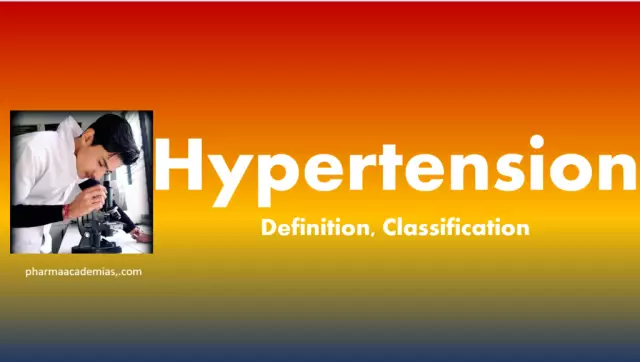- Author Curtis Blomfield [email protected].
- Public 2023-12-16 20:44.
- Last modified 2025-01-23 17:01.
Primary arterial hypertension of unclear origin is understood as essential hypertension. That is, it is an independent form in which the increase in pressure occurs for no apparent reason and is not associated with other pathologies. Hypertension should be distinguished from secondary hypertension, in which high blood pressure is a symptom of any disease from among the cardiovascular, renal, neurological, endocrine, and others.
Since the beginning of the 20th century, more than one classification has been proposed. Hypertension was subdivided into types according to one or more criteria. This distinction is necessary because it is important to correctly identify the form of the disease for successful treatment.

What classification is used today? Hypertension can be systematized according to the appearance of the patient, the causes of occurrence, the level of pressure increase, the nature of the course, the degree of organ damage, and options for increasing blood pressure. Classification by appearance is not used today, the rest are stillare actively used in medical practice.
Today, doctors around the world most often divide hypertension by the level of blood pressure and the degree of damage to organs in which the blood supply is impaired due to the disease.
Practical value in medicine is the classification of hypertension by the level of pressure in mm Hg. Art.:
- optimal value - 120/80;
- normal - 120/80-129/84;
- normal border - 130/85-139/89;
- I degree AH - 140/90-159/99;
- II degree AH - 160/100-179/109;
- III degree AH - more than 180/110.
Hypertension. Classification by pressure level
There are three degrees of the disease, while their names characterize not the patient's condition, but only the level of pressure:
- I degree - mild: BP may be in the range of 140-159/90-99;
- II degree - moderate: BP is 160-179/100-109;
- III degree - severe: BP over 180/110.
Classification of hypertension by stages
In this case, the disease is divided according to the degree of organ damage and the following stages are distinguished:
-
First. The increase in blood pressure is slight and intermittent, usually occurs during exercise. There are no changes in the organs. There are no complaints, the pressure normalizes after rest without taking drugs.
-
Second. There is a more persistent increase in blood pressure, in connection with which there are changes in the organs, but theyfunctions are intact.

classification of hypertension by stages Most often there is an increase in the left ventricle. In addition, changes in the kidneys, brain vessels, and retina are possible. It is necessary to constantly control blood pressure and take appropriate medications.
- Third stage. The pressure is kept at a high level. The organs are not only changed, but their work is also disrupted. As a rule, renal and heart failure develops, hemorrhages and degenerative changes in the fundus of the eye, atrophy and swelling of the optic nerve appear. Medication indicated.
Other classifications
The next classification. Hypertension can have four types of high blood pressure:
- systolic - elevated upper, lower - no more than 90 mm Hg. Art.;
-
diastolic - only the lower one is elevated, the upper one is less than 140 mm Hg. Art.;

hypertension classification - systolic-diastolic;
- labile hypertension - pressure drops without the use of antihypertensive drugs.
There is another classification. Hypertension can be divided according to the nature of the course. There are two forms of the disease: benign and malignant.
In the first case, hypertension develops slowly, goes through three stages according to the degree of pressure increase and the severity of changes in the internal organs due to high blood pressure.
Malignant form occursinfrequently. It usually develops in young people and children, it is characterized by consistently high blood pressure, severe organ damage. It is characterized by such signs as headaches, convulsions, vomiting, transient blindness, coma.






